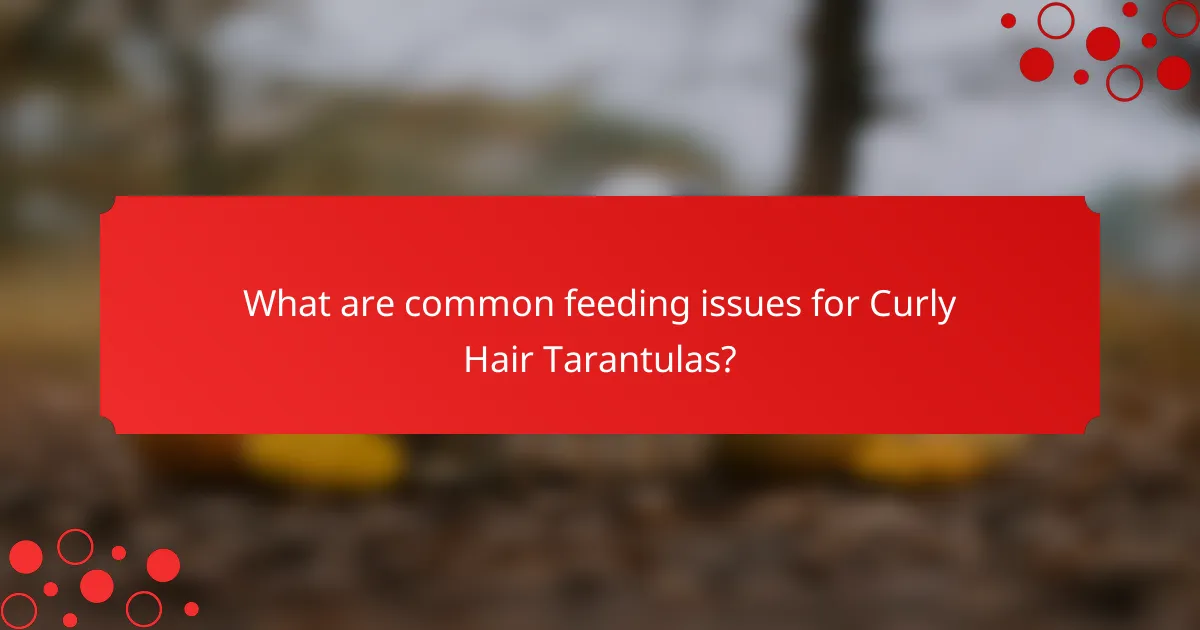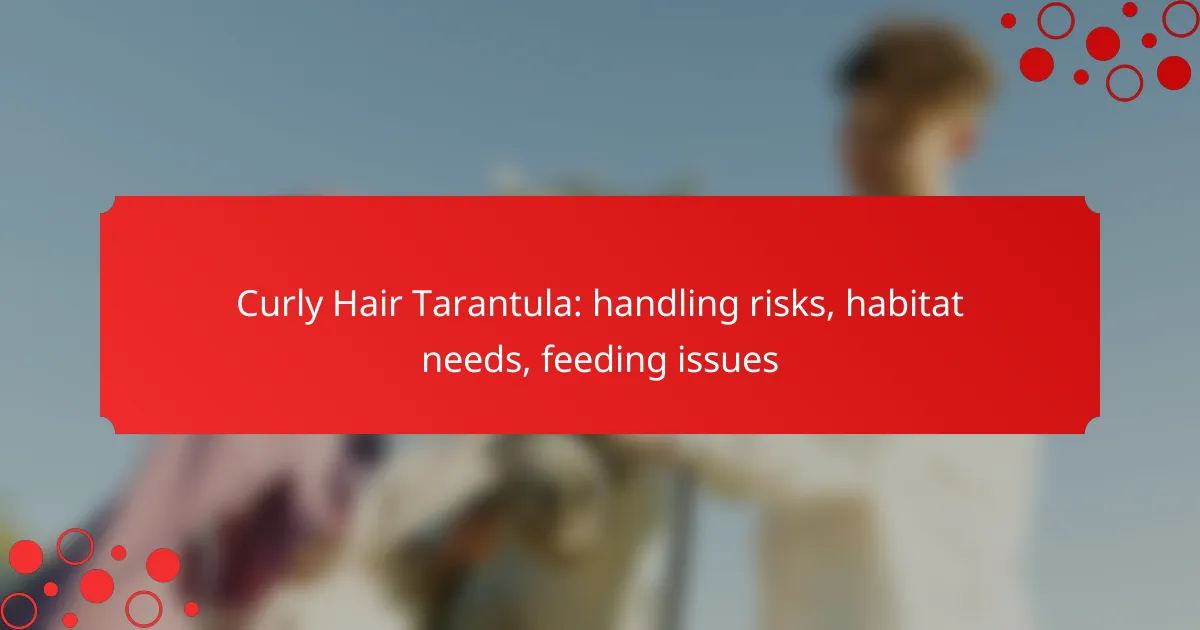Curly Hair Tarantulas are fascinating creatures that require careful handling and specific habitat conditions to thrive. Ensuring their safety and well-being involves understanding their behavior and meeting their needs for space, humidity, and temperature. Additionally, addressing common feeding issues is essential for maintaining their health in captivity.

How to handle Curly Hair Tarantulas safely?
Handling Curly Hair Tarantulas requires caution to ensure both your safety and the well-being of the spider. Proper techniques and awareness of their behavior can minimize risks during handling.
Use gloves for protection
Wearing gloves is essential when handling Curly Hair Tarantulas to protect your skin from potential bites and irritants. Choose gloves that are thin enough to allow for dexterity, yet thick enough to provide a barrier against fangs.
Latex or nitrile gloves are commonly recommended as they offer a good balance of sensitivity and protection. Ensure that the gloves fit well to maintain a secure grip on the tarantula.
Minimize stress during handling
To reduce stress on your Curly Hair Tarantula, handle it in a calm environment free from loud noises and sudden movements. This spider species is known for being relatively docile, but they can become agitated if they feel threatened.
Limit handling sessions to brief periods, ideally no longer than a few minutes, to prevent overwhelming the tarantula. Always approach handling with a gentle demeanor to help keep the spider relaxed.
Keep a secure grip
Maintaining a secure grip is crucial when handling Curly Hair Tarantulas. Use both hands to support the spider, cradling its body while avoiding pressure on its abdomen.
Position your hands low to the ground or over a soft surface to prevent injury if the tarantula escapes. A firm yet gentle hold will help you manage the spider without causing distress.
Limit handling frequency
Limiting the frequency of handling is important for the health of your Curly Hair Tarantula. Frequent handling can lead to stress and may disrupt their natural behaviors.
Consider handling your tarantula only once every few weeks, allowing it ample time to acclimate to its environment and recover from any handling stress.
Observe body language
Being attentive to your Curly Hair Tarantula’s body language is vital for safe handling. Signs of stress or discomfort include leg retraction, rapid movements, or a defensive posture.
If you notice any of these behaviors, it’s best to return the tarantula to its enclosure immediately. Understanding these cues will help you gauge when it’s appropriate to handle your spider and when to give it space.

What are the habitat needs for Curly Hair Tarantulas?
Curly Hair Tarantulas require specific habitat conditions to thrive, including appropriate space, humidity, temperature, and hiding spots. Meeting these needs ensures their health and well-being in captivity.
Provide a terrarium with adequate space
A terrarium for a Curly Hair Tarantula should be spacious enough to allow for movement and exploration. A minimum size of 10 gallons is recommended for adults, while juveniles can thrive in smaller enclosures. Ensure the terrarium has a secure lid to prevent escapes.
Consider vertical space as well; these tarantulas enjoy climbing. Adding branches or other climbing structures can enhance their environment and promote natural behaviors.
Maintain humidity levels between 60-70%
Curly Hair Tarantulas thrive in humidity levels of 60-70%. This range mimics their natural habitat and helps prevent dehydration. Use a hygrometer to monitor humidity levels accurately.
To maintain proper humidity, lightly mist the substrate and provide a water dish. However, avoid excessive moisture, as it can lead to mold growth and health issues.
Include hiding spots and substrate
Providing hiding spots is crucial for the well-being of Curly Hair Tarantulas, as they are naturally secretive creatures. Use items like cork bark, caves, or commercially available hides to create safe spaces.
For substrate, choose materials like coconut fiber or peat moss, which allow for burrowing and help maintain humidity. A substrate depth of at least 2-3 inches is ideal for adults.
Ensure proper temperature gradient
Curly Hair Tarantulas require a temperature gradient within their terrarium, typically between 75°F to 85°F (24°C to 29°C). This gradient allows them to regulate their body temperature effectively.
Use a heat mat or lamp to create this gradient, placing it on one side of the terrarium. Always provide a cooler area for the tarantula to retreat to if it gets too warm.

What are common feeding issues for Curly Hair Tarantulas?
Curly Hair Tarantulas often face several feeding issues that can affect their health and well-being. Understanding these challenges is crucial for proper care and ensuring they receive adequate nutrition.
Inconsistent feeding schedules
Inconsistent feeding schedules can lead to stress and health problems in Curly Hair Tarantulas. It’s essential to establish a regular feeding routine, typically every 5 to 7 days, depending on the spider’s age and size.
Young tarantulas may require more frequent feedings, while adults can be fed less often. Keeping a consistent schedule helps maintain their appetite and overall health.
Improper prey size
Feeding Curly Hair Tarantulas prey that is too large can cause feeding issues. The general rule is to offer prey that is about the same size as the tarantula’s body width.
Using appropriately sized prey ensures that the tarantula can consume its food without difficulty, reducing the risk of injury or stress during feeding.
Signs of stress affecting appetite
Stress can significantly impact a Curly Hair Tarantula’s appetite. Common signs of stress include hiding, webbing excessively, or displaying defensive behaviors.
If a tarantula shows these signs, it may be necessary to reassess its environment, including temperature, humidity, and habitat setup, to reduce stress and encourage feeding.
Use live or pre-killed insects
Offering live or pre-killed insects can affect feeding success. Live insects can stimulate a tarantula’s hunting instincts, making them more likely to eat.
However, pre-killed insects are safer for the tarantula, as they eliminate the risk of injury. It’s important to monitor the tarantula’s response to both types of prey and adjust feeding practices accordingly.

How to create an ideal environment for Curly Hair Tarantulas in the UK?
Creating an ideal environment for Curly Hair Tarantulas in the UK involves selecting the right terrarium size, using suitable substrate, and monitoring climate conditions. These factors are crucial for the health and well-being of your tarantula.
Choose appropriate terrarium size
The terrarium for a Curly Hair Tarantula should ideally be at least 30 cm x 30 cm x 30 cm, providing ample space for movement and exploration. A larger enclosure can be beneficial, especially as the spider grows, but ensure it is not too spacious, as this can lead to stress.
When selecting a terrarium, consider vertical space as well, as these tarantulas enjoy climbing. Secure the enclosure with a tight-fitting lid to prevent escapes, as these spiders can be surprisingly agile.
Use local substrate options
For substrate, use a mix of coconut fiber and peat moss, which are both readily available in the UK. This combination retains moisture while allowing for proper drainage, mimicking the tarantula’s natural habitat.
A substrate depth of around 5-10 cm is recommended to allow for burrowing, which is a natural behavior for Curly Hair Tarantulas. Avoid using sand or gravel, as these can cause health issues if ingested.
Monitor climate conditions
Maintaining the right climate is essential for the well-being of Curly Hair Tarantulas. Aim for a temperature range of 24-28°C during the day and slightly cooler at night. A heat mat can help achieve this, but ensure it is not directly under the enclosure to prevent overheating.
Humidity levels should be kept between 60-70%. Regular misting can help maintain this, but be cautious not to overdo it, as excessive moisture can lead to mold growth and health problems for your tarantula.

What are the risks associated with Curly Hair Tarantulas?
Handling Curly Hair Tarantulas comes with certain risks, primarily related to potential bites and allergic reactions. While these tarantulas are generally docile, understanding the risks can help ensure safe interactions.
Potential bites and venom effects
Curly Hair Tarantulas are known for their relatively mild venom, which is not considered dangerous to humans. However, a bite can still be painful and may cause localized swelling, redness, or irritation. It’s crucial to handle them gently and avoid sudden movements that could provoke a defensive bite.
If bitten, clean the wound thoroughly and monitor for any signs of infection. Most bites will heal within a few days, but individuals with compromised immune systems should seek medical advice promptly.
Allergic reactions in sensitive individuals
Some individuals may experience allergic reactions when handling Curly Hair Tarantulas, even without being bitten. Symptoms can include itching, rash, or respiratory issues due to exposure to the tarantula’s hairs or body fluids. Those with known allergies to arachnids should exercise caution.
To minimize the risk of an allergic reaction, wash your hands after handling the tarantula and avoid touching your face. If you notice any allergic symptoms, discontinue handling and consult a healthcare professional if necessary.



